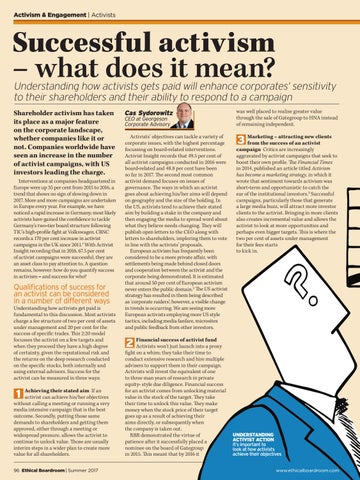Activism & Engagement | Activists
Successful activism – what does it mean?
Understanding how activists gets paid will enhance corporates’ sensitivity to their shareholders and their ability to respond to a campaign Shareholder activism has taken its place as a major feature on the corporate landscape, whether companies like it or not. Companies worldwide have seen an increase in the number of activist campaigns, with US investors leading the charge. Interventions at companies headquartered in Europe were up 35 per cent from 2015 to 2016, a trend that shows no sign of slowing down in 2017. More and more campaigns are undertaken in Europe every year. For example, we have noticed a rapid increase in Germany; most likely activists have gained the confidence to tackle Germany’s two-tier board structure following TIC’s high-profile fight at Volkswagen. CBNC records a 170 per cent increase in activist campaigns in the UK since 2011.1 With Activist Insight recording that in 2016, 67.5 per cent of activist campaigns were successful, they are an asset class to pay attention to. A question remains, however: how do you quantify success in activism – and success for who?
Qualifications of success for an activist can be considered in a number of different ways
Understanding how activists get paid is fundamental to this discussion. Most activists charge a fee structure of two per cent of assets under management and 20 per cent for the success of specific trades. This 2:20 model focusses the activist on a few targets and when they proceed they have a high degree of certainty, given the reputational risk and the returns on the deep research conducted on the specific stocks, both internally and using external advisors. Success for the activist can be measured in three ways:
1
Achieving their stated aim If an activist can achieve his/her objectives without calling a meeting or running a very media intensive campaign that is the best outcome. Secondly, putting those same demands to shareholders and getting them approved, either through a meeting or widespread pressure, allows the activist to continue to unlock value. Those are usually interim steps in a wider plan to create more value for all shareholders. 96 Ethical Boardroom | Summer 2017
Cas Sydorowitz
was well placed to realise greater value through the sale of Gategroup to HNA instead of remaining independent.
Activists’ objectives can tackle a variety of corporate issues, with the highest percentage focussing on board-related interventions. Activist Insight records that 49.5 per cent of all activist campaigns conducted in 2016 were board-related and 48.8 per cent have been so far in 2017. The second most common activist demand focuses on issues of governance. The ways in which an activist goes about achieving his/her aims will depend on geography and the size of the holding. In the US, activists tend to achieve their stated aim by building a stake in the company and then engaging the media to spread word about what they believe needs changing. They will publish open letters to the CEO along with letters to shareholders, imploring them to vote in line with the activists’ proposals. European activism has frequently been considered to be a more private affair, with settlements being made behind closed doors and cooperation between the activist and the corporate being demonstrated. It is estimated that around 50 per cent of European activism never enters the public domain.2 The US activist strategy has resulted in them being described as ‘corporate raiders’; however, a visible change in trends is occurring. We are seeing more European activists employing more US style tactics, including media fanfare, microsites and public feedback from other investors.
– attracting new clients 3 Marketing from the success of an activist
CEO at Georgeson Corporate Advisory
campaign Critics are increasingly aggravated by activist campaigns that seek to boost their own profile. The Financial Times in 2014, published an article titled Activism has become a marketing strategy, in which it wrote that sentiment towards activism was short-term and opportunistic to catch the ear of the institutional investors. 3 Successful campaigns, particularly those that generate a large media buzz, will attract more investor clients to the activist. Bringing in more clients also creates incremental value and allows the activist to look at more opportunities and perhaps even bigger targets. This is where the two per cent of assets under management for their fees starts to kick in.
success of activist fund 2 Financial Activists won’t just launch into a proxy
fight on a whim; they take their time to conduct extensive research and hire multiple advisers to support them in their campaign. Activists will invest the equivalent of one to three man years of research in private equity- style due diligence. Financial success for an activist comes from unlocking material value in the stock of the target. They take their time to unlock this value. They make money when the stock price of their target goes up as a result of achieving their aims directly, or subsequently when the company is taken out. RBR demonstrated the virtue of patience after it successfully placed a nominee on the board of Gategroup in 2015. This meant that by 2016 it
UNDERSTANDING ACTIVIST ACTION It’s important to look at how activists achieve their objectives www.ethicalboardroom.com
